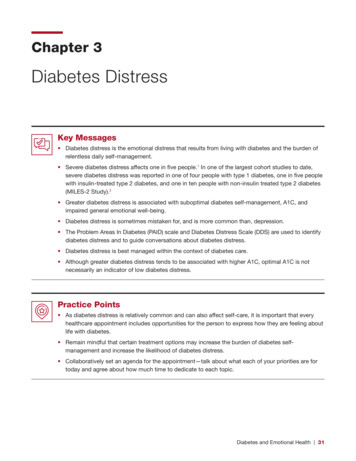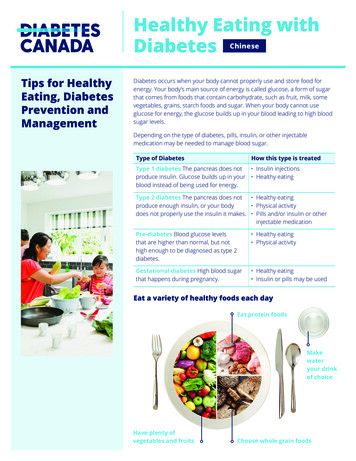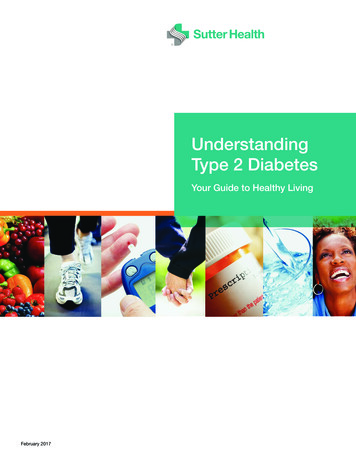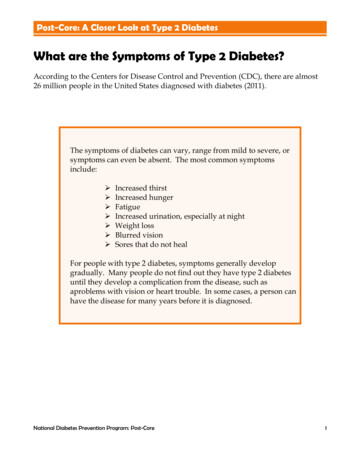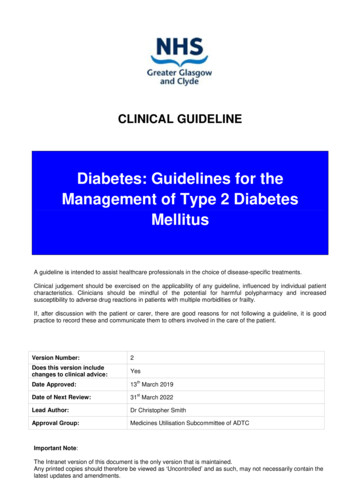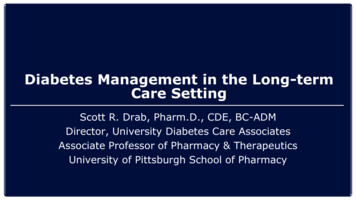
Transcription
Diabetes Management in the Long-termCare SettingScott R. Drab, Pharm.D., CDE, BC-ADMDirector, University Diabetes Care AssociatesAssociate Professor of Pharmacy & TherapeuticsUniversity of Pittsburgh School of Pharmacy
Objectives Discuss treatment considerations for managementof type 2 diabetes in the long-term care setting Review A1C goals and guidelines for older adultswith diabetes Identify the hazards of sliding scale insulin Discuss strategies to avoid hypoglycemia in thelong-term care setting Highlight type 2 diabetes treatment options
Diabetes Management Is Needed to OptimizeOutcomes in the Growing Long-term Care Population Prevalence of diabetes in LTC is increasing1 Individuals with diabetes in LTC are more likely to requirehospitalization and have a higher riskof unfavorable outcomes2,3 Avoidance of hyper- and hypoglycemia is essentialfor individuals with diabetes in LTC4LTC long-term care1. Zhang X et al. J Am Geriatr Soc. 2010;58(4):724-730. 2. Dybicz SB et al. Am J Geriatr Pharmacother. 2011;9(4):212-223.3. Resnick HE et al. Diabetes Care. 2008;31(2):287-288. 4. American Medical Directors Association. Diabetes Management in theLong-Term Care Setting: Clinical Practice Guideline. Columbia, MD: American Medical Directors Association; 2010.
Barriers to Effective Diabetes Managementfor Individuals in the Long-term Care Setting Frailty and physical impairment Existence of multiple coexisting medical conditions Elevated risk for hypoglycemia Increased tendency to develop infections Presence of insulin resistance Preexisting complications of diabetes Presence of impaired cognition or dementiaAmerican Medical Directors Association. Diabetes Management in the Long-Term Care Setting: Clinical Practice Guideline.Columbia, MD: American Medical Directors Association; 2010.
Treatment Considerations for IndividualsWith Diabetes in LTC Comorbidities Duration of diabetes Blood glucose levels Prognosis Individual treatment goalsAmerican Medical Directors Association. Diabetes Management in the Long-Term Care Setting: Clinical Practice Guideline.Columbia, MD: American Medical Directors Association; 2010.
American Medical Directors Association (AMDA) HasEstablished Diabetes Management Guidelines for LTC Elements of a good systematic approach to diabetesmanagement in the LTC setting include:– Incorporating an interdisciplinary team approach to overalldiabetes management– Reviewing glycemic control protocols and appropriate interventions– Using outcome and process indicators to measure performance– Monitoring residents’ clinical conditions on a regular basisAmerican Medical Directors Association. Diabetes Management in the Long-Term Care Setting: Clinical Practice Guideline.Columbia, MD: American Medical Directors Association; 2010.
A1C Goals for Older Adults With DiabetesAmerican MedicalDirectors Association1A1C goalSet target range appropriate forindividual residents, staying close toADA and AGS guidelinesMore modest goals may be set forthose with a life expectancy 5 yearsAmerican GeriatricsSociety (AGS)2,3 7% for adults with goodfunctional statusGoals should beindividualized 8% for frail older adultsADA American Diabetes Association1. American Medical Directors Association. Diabetes Management in the Long-Term Care Setting: Clinical Practice Guideline.Columbia, MD: American Medical Directors Association; 2010. 2. Brown AF et al; California Health Care Foundation/AmericanGeriatrics Society Panel on Improving Care for Elders With Diabetes. J Am Geriatr Soc. 2003;51(5 suppl):S265-S280. 3. KirkmanMS et al; Consensus Development Conference on Diabetes and Older Adults. J Am Geriatr Soc. 2012;60(12):2342-2356.
ADA Consensus Guidelines on Diabetesin Older AdultsHealth StatusRationaleA1CGoal, %FPG,mg/dLBedtimeBG,mg/dLBloodPressure,mm HgLipidsHealthy Few other chronic illnesses Intact cognition and functionLonger lifeexpectancy 7.590-13090-150 140/80Statin unlesscontraindicatedor not toleratedComplex/intermediate health Multiple chronic illnesses* or 2 instrumental ADL impairments or Mild to moderate cognitive impairmentIntermediate lifeexpectancy, hightreatment burden,hypoglycemiavulnerability, fallrisk 8.090-150100-180 140/80Statin unlesscontraindicatedor not toleratedVery complex/poor healthLimited lifeConsider Long-term care orexpectancy100likelihood of End-stage chronic illnesses† or 8.5‡110-200 150/90makes benefit180benefit with 2 ADL dependencies oruncertainstatin Moderate to severe cognitive impairmentADL activities of daily living; BG blood glucose; FPG fasting plasma glucose.* 3 or more chronic illnesses requiring medications or lifestyle management. † The presence of a single end-stage chronic illness suchas stage III–IV congestive heart failure or oxygen-dependent lung disease, chronic kidney disease requiring dialysis, or uncontrolledmetastatic cancer may cause significant symptoms or impairment of functional status and significantly reduce life expectancy.‡ A1C of 8.5% is 200 mg/dL estimated average glucose; looser targets may expose patients to risks from acute "acute risks fromglycosuria, dehydration, hyperglycemic hyperosmolar syndrome, and poor wound healing.Kirkman MS et al. Diabetes Care. 2012;35(12):2650-2664.
Antihyperglycemic Therapy in Type 2 Diabetes:General RecommendationsInitial nsMore complexinsulin strategiesHealthy eating, weight control, increased physical activityMetforminMetformin SulfonylureaMetformin TZDMetformin Sulfonylurea TZDorDPP-4iorGLP-1RAorInsulinMetformin TZD SUorDPP-4iorGLP-1RAorInsulinMetformin DPP-4iMetformin GLP-1RAMetformin Insulin(usually basal)Metformin DPP-4i SUorTZDorInsulinMetformin GLP-1RA SUorTZDorInsulinMetformin Insulin(usuallybasal) TZDorDPP-4iorGLP-1RAInsulin (multiple daily doses)* Consider beginning at this stage in individuals with very high A1C (eg, 9.0%).DPP-4i dipeptidyl peptidase-4 inhibitor; GLP-1RA glucagon-like peptide-1 receptor agonist; SU sulfonylurea; TZD thiazolidinedione.Inzucchi SE et al. Diabetes Care. 2012;35(6):1364-1379.
Antihyperglycemic Therapy in Type 2 Diabetes:General Recommendations (cont’d)Could be consideredOptimal insulin regimenNon-insulin regimensBasal insulin only(usually with oral agents)Basal insulin 1 (mealtime) rapid-actinginsulin injectionPremixedinsulin twice dailyBasal insulin 2 (mealtime) rapid-actinginsulin injectionsMore flexibleMod moderate.Inzucchi SE et al. Diabetes Care. 2012;35(6):1364-1379.Less flexibleNumber ofinjectionsRegimencomplexity1Low2Mod 3HighFlexibility
Deciding When and How to InitiateInsulin Therapy All patients with type 1 diabetes Initiate insulin therapy earlier in individuals who are unable toachieve glucose targets with their current treatment strategy1– A1C 9.0% and symptomatic hyperglycemia1– Uncontrolled management on combination OADs2 Determine the appropriate insulin regimen and insulin type(s)based on the individual’s needs21. Handelsman Y et al; AACE Task Force for Developing Diabetes Comprehensive Care Plan. Endocr Pract. 2011;17(suppl 2):1-53.2. American Medical Directors Association. Diabetes Management in the Long-Term Care Setting: Clinical Practice Guideline.Columbia, MD: American Medical Directors Association; 2010.
AMDA Recommends Insulin in Patients WithDiabetes for a Variety of Clinical Situations in LTCClinical SituationSuggested InsulinAdding insulin to oral agents Basal insulin, predinner insulin mixture, orintermediate-acting insulinTreating well-controlledindividual who has consistenteating patterns Basal-bolus insulin regimen, twice-daily insulinmixture, or split-mixed intermediate- and shortacting insulinTreating poor glycemic control Insulin regimen per physician’s recommendationAmerican Medical Directors Association. Diabetes Management in the Long-Term Care Setting: Clinical Practice Guideline.Columbia, MD: American Medical Directors Association; 2010.
What Is Sliding Scale Insulin (SSI)? SSI utilizes dosing of short-acting insulin based on current bloodglucose measurements, without a basal insulin component in theindividual’s regimen1,2 Although exclusive use of SSI is not recommended, it is stillwidely used in some hospitals as a treatment option2-4 AMDA does not recommend the prolonged use of SSI.5Individuals on SSI should be:– Re-evaluated within 1 week– Converted to fixed daily insulin doses that minimize the use of correction dosing1. Guthrie DW et al. J Fam Pract. 2011;60(5):266-270. 2. Lilley SH, Levine GI. Am Fam Physician. 1998;57(5):1079-1088.3. American Diabetes Association. Diabetes Care. 2013;36(suppl 1):S11-S66. 4. Handelsman Y et al; AACE Task Force forDeveloping Diabetes Comprehensive Care Plan. Endocr Pract. 2011;17(suppl 2):1-53. 5. American Medical DirectorsAssociation. Diabetes Management in the Long-Term Care Setting: Clinical Practice Guideline. Columbia, MD: American MedicalDirectors Association; 2010.
Physicians Prescribe Sliding Scale InsulinDespite Potential Risks54% Approximately 54% of residents* receivedSSI at the time of insulin initiation(n 2956) Of these, 83% of residentsremained on SSI through theend of the study†83%(n 2452)* A total of 5482 residents received insulin therapy during their stay at a nursing home until the end of study follow-up.† Individuals included in this study were followed for a mean of 6.4 6.1 months.Pandya N et al. J Am Med Dir Assoc. 2008;9(9):663-669.
Hazards of Sliding Scale Insulin Increases the risk of both hypoglycemia and hyperglycemia1 Uses a reactive approach that can lead to rapid swings in bloodglucose, resulting in hyperglycemia and hypoglycemia2 Is likely to continue without appropriate modification whenused as an admission regimen2Hazards of sliding scale insulin use exceed the advantageof its convenience31. American Diabetes Association. Diabetes Care. 2013;36(suppl 1):S11-S66. 2. American Diabetes Association. Diabetes Care.2006;29(suppl 1):S4-S42. 3. Hirsch IB. JAMA. 2009;301(2):213-214.
Basal-Bolus Therapy Is Effectivefor the Maintenance of Glycemic ControlPlasma Insulin, U/mLEffective insulin therapy may contain basal, bolus,and supplemental doses to achieve target goals175Breakfast LunchDinnerBolus insulinBasal insulin50Correction insulin25008:00Adapted from Bray et al2Basal-bolus is moreeffective atglycemic control vssliding scaletherapy in medicaland surgicalpatients3,412:00 16:00 20:00 24:00 4:00 8:00Time1. Moghissi ES et al; American Association of Clinical Endocrinologists; American Diabetes Association. Endocr Pract.2009;15(4):353-369. 2. Bray B. Consult Pharm. 2008;23(Suppl B):17-23. 3. Roberts G et al. Med J Aust. 2012;196(4):266-269.4. Umpierrez GE et al. Diabetes Care. 2011;34(2):256-261.
Insulin Initiation Begins With an Estimationof the Total Daily Dose Determine appropriate insulin regimen and insulin type basedon individual needs Estimate the total daily dose (TDD) requirements based on:– Body weight– Level of physical activity– Comorbid conditionsDiabetes management must be individualized basedon an individual’s medical and functional status.American Medical Directors Association. Diabetes Management in the Long-Term Care Setting: Clinical Practice Guideline.Columbia, MD: American Medical Directors Association; 2010.
Key Steps in the Initiation of a Basal-BolusDosing Regimen Use the estimated total daily dose to determine the basal andbolus insulin dose1Step 3Step 2Step 1Space mealtime insulinat each meal 1/3Divide 50/50 50% Basal &50% BolusCalculate estimated TDD of insulin Guidelines and treatment protocols provide detailed strategiesfor the initiation of basal-bolus therapy1-41. American Medical Directors Association. Diabetes Management in the Long-Term Care Setting: Clinical Practice Guideline. Columbia,MD: American Medical Directors Association; 2010. 2. Umpierrez GE et al. Diabetes Care. 2007;30(9):2181-2186. 3. DeSantis AJ et al.Endocr Pract. 2006;12(5):491-505. 4. Lansang MC, Umpierrez GE. Diabetes Spectr. 2008;21(4):248-255.
Benefits of Insulin Analogsvs Human Insulin Insulin analogs are derivatives of human insulin that haveundergone one or more chemical modifications to alter the timeaction profile of the insulin– Both are produced by recombinant DNA (rDNA) technology Time-action profile of subcutaneous human insulin does notalways match physiologic demand Insulin analogs were designed to more closely mimic normalphysiologic insulin secretion patternsBrange J, Vølund A. Adv Drug Deliv Rev. 1999;35(2-3):307-335.
Basal Analogs Offer Advantagesfor Individuals on Basal Therapy in LTCSerum Insulin LevelTheoretical insulin profile1Basal analogNPHCompared to NPH, basalinsulin analogs provide2: Reduced rate ofhypoglycemia Once-daily dosing in T2DM Similar reduction in FPG0Time, h24FPG fasting plasma glucose; NPH neutral protamine Hagedorn.1. Brunton S et al. J Fam Pract. 2005;54(5):445-452. 2. Tanwani LK. Am J Geriatr Pharmacother. 2011;9(11):24-36.
Advantages of Rapid-Acting Insulin Analogsfor Individuals on a Basal-Bolus Regimen in LTCRelative Insulin EffectsTheoretical insulin profile1*Rapid-actinginsulin analogsRegular HumanInsulin (RHl)010Time, hCompared to RHI, rapidacting insulin analogs2,3: Provide a more physiologicresponse Have a more rapid onsetand shorter duration ofaction Are associated withless severe episodesof hypoglycemia20* Theoretical representations of insulin levels over time. Adapted from Freeman JS. 11. Freeman JS. J Am Osteopath Assoc. 2009;109(1):26-36. 2. Tanwani LK. Am J Geriatr Pharmacother. 2011;9(11):24-36.3. Handelsman Y et al; AACE Task Force for Developing Diabetes Comprehensive Care Plan. Endocr Pract. 2011;17(suppl 2):1-53.
Avoidance of HypoglycemiaIs Essential for IndividualsWith Diabetes in LTC
Risk Factors for HypoglycemiaPatient CharacteristicsBehavioral and Treatment Factors Older age1 Missed meals2 Female gender1 Elevated A1C1 African American ethnicity1 Insulin or sulfonylurea therapy1 Longer duration of diabetes1 Neuropathy1 Renal impairment1 Previous hypoglycemia21. Miller ME et al; ACCORD Investigators. BMJ. 2010;340:b5444. 2. Briscoe VJ, Davis SN. Clin Diabetes. 2006;24(3):115-121.
Relative Rates of Severe HypoglycemiaWith InsulinIncreasing ratesof hypoglycemiaMostfrequentPrandial andpremixMorefrequentBasal LessfrequentBasalonlyNPH neutral protamine Hagedorn.Moghissi E et al. Endocr Pract. 2013;19(3):526-535.Human insulinAnalog insulinsPremix insulinsBasal plus 2-3 prandialBasal plus 1 prandialNPHBasal analogs
Addressing Hypoglycemia in the LTC Setting:AMDA Recommendations for Policy and ProceduresRule of15ConsidertheIndividualAvoidOvertreating Treatment of hypoglycemia generally follows the “Rule of 15”–––Give 15 g of glucose or carbohydrate (eg, ½ cup juice, ½ cup apple sauce,1 cup milk, 1 tube glucose gel, 3 glucose tablets)*Wait 15 minutesRecheck blood glucose levels. If blood glucose is below target, give another15 g of glucose or carbohydrate Consider the specific needs of the individual in LTC(eg, unconscious or comatose individuals, or individuals who cannotreceive glucose by mouth or feeding tube)–Consider other subcutaneous, intramuscular, or intravenous options Avoid the overtreatment of hypoglycemia. Overtreatment can result insignificant hyperglycemia within the next 4-6 hours* Treat hypoglycemia with a sandwich or snack containing protein.American Medical Directors Association. Diabetes Management in the Long-Term Care Setting: Clinical Practice Guideline.Columbia, MD: American Medical Directors Association; 2010.
Summary Individualized goals and treatment strategies are recommendedfor patients with type 2 diabetes in LTC Insulin analogs offer advantages to patients with type 2 diabetes Basal-bolus insulin therapy is the preferred approach for glycemiccontrol; sliding scale insulin is discouraged Avoidance of hypoglycemia is essential for individuals withdiabetes in LTC
Questions?
Thank you! 2013 Novo NordiskAll rights reserved.0913-00017943-1October 2013
Outcomes in the Growing Long-term Care Population LTC long-term care 1. Zhang X et al. J Am Geriatr Soc. 2010;58(4):724-730. 2. Dybicz SB et al. Am J Geriatr Pharmacother. 2011;9(4):212-223. 3. Resnick HE et al. Diabetes Care. 2008;31(2):287-288. 4. American Medical Directors Association. Diabetes Management in the Long-Term Care Setting .


